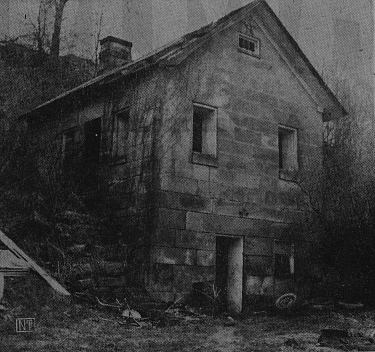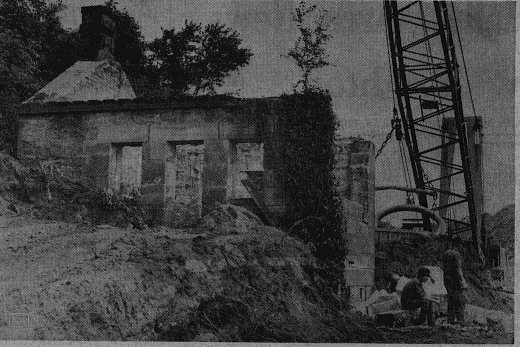
It's just a stone house sitting against a hillside between Darlington and Enon Valley.
But it's stones are more than just helter skelter stones, and it's more than just a house, and it stands on the brink of destruction by a bulldozer blade to make way for continued coal stripping.
Some estimate thes tructure, which is really a large spring house that possibly doubled as a smoke house or residence on the second floor, to be 150 years old. No one really knows at this point. However, the stones are all hand cut. You can see the chip marks on the sides, and they range in size from one or two feet square to four feet by two feet by two feet.
In the spring house, at ground, level, the water pours out of the hillside into a 1arge hand cut stone trough and the overflow into a fifteen foot long two foot wide hand cut stone trough.
A tunnel extends 20 feet toward the back of the house into a coal vein where the former owners undoubtedly mined their own coal either for home or commercial. use.
On the second- floor, now largely rotted out although the flooring isn't of the same vintage as the stone, there are two doors and two shallow fire places. The chimney still stands.
But how long will the building stand? Will it fall to the bulldozer shovel, and another part of Western Pennsylvania history be buried forever? Perhaps that's too dramatic, but it is the startled concern of the Little Beaver Historical Society, and a member, Mrs. Marjorie Douthitt, R.D. 2, Darlington who brought it to our attention. I
They've stopped the bulldozer -- temporarily. Operator Cornelius (Red) Dodds, has agreed. to hold off until the Society's May meeting. But what then? And what then about many, many similar structures in this area that could and- should be preserved?
We called in Albert Miller, owner, and operator of Meadoweroft, a "living" non-profit village near Avella where rustic America is being preserved in minute and accurate detail. Fascinated by the stone structure, Miller noted that it would require $25,000 just to move it to his site, something he isn't prepared for now. However, he urged that it be preserved on the present site for possible future use, and that a survey of all such buildings be made.
We'd like to see a real effort made to preserve not only this structure, but others like it. And we'd like to see backing for, the Little Beaver Historical Society that works with precious little resources.
The greatest resources, however, are human, and personal interest and enthusiasm can sometimes accomplish more than money.

The old stone spring house in Darlington Township, threatened by a strip mine 'drag line, has found salvation from the owners of that same drag line.
The house, built about 1850 of huge hand cut stone, and containing a 22-foot long hand cut water. trough, and a tunnel reaching back into coal seam, was brought to public attention in April by Mrs. Marjorie Douthitt of Darlington.
THE HOUSE was smack in the road of strip mine operation .and due for destruction. The strip mine operator, Cornelius '(Red) Dodds, permitted the Little Beaver Historical Society several days to take action to remove the house. However, equipment to move it, and funds to pay both for the disassembling and reassembling couldn't be arranged.
Finally, this week, Mrs. Douthitt wrote a letter pleading with Rochez Industries, Inc., East Pittsburgh, backers of Dodds, to help save the structure. At 9:30 a.m., the Rochez brothers, Leo and Joe, responded by disassembling the building stone by stone (with the help of a high lift) to get it out of the way of the operation and permit the local society to rebuild it elsewhere.
THE SOCIETY now is seeking public funds to move the blocks of the historically significant building from its location off Echo Springs Road between Darlington and Enon Valley, to a site to be donated by the Fred Wallaces, Wallace Road, Darlington.
Ironically, it was William S. Wallace, a fourth cousin to the Wallaces who is believed to have hauled in the water trough for the building back in 1850. The Wallaces didn't discover this until after they decided to donate the land.
THE BUILDING was believed to have been built by William McClurg for $3,000. McClurg's great grandson's wife, Mrs. Neva McGeehan of East Palestine, Ohio, now in her late 70s, furnished the information to Mrs. Douthitt.
Members of the society spent several hours Wednesday numbering each stone and piece of the house.
